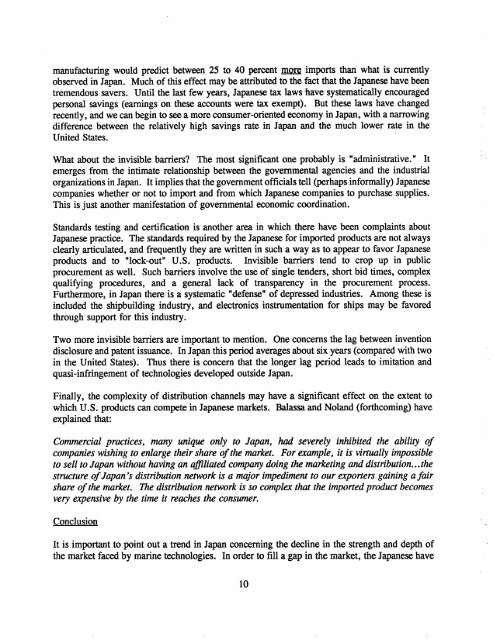WHOI-90-52
WHOI-90-52
WHOI-90-52
You also want an ePaper? Increase the reach of your titles
YUMPU automatically turns print PDFs into web optimized ePapers that Google loves.
manufacturing would predict between 25 to 40 percent more imports than what is currently<br />
observed in Japan. Much of this effect may be attributed to the fact that the Japanese have been<br />
tremendous savers. Until the last few yeas, Japanese ta laws nave systematically encouraged<br />
personal savings (eaings on these accounts were ta exempt). But these laws have changed<br />
recntly, and we ca begin to se a more consumer-oriente economy in Japan, with a narowing<br />
difference between the relatively high savings rate in Japan and the much lower rate in the<br />
United States.<br />
What about the invisible barers? The most significat one probably is "administrtive. II It<br />
emerges from the intimate relationship between the governmenta agencies and the industrial<br />
organizations in Japan. It implies that the government officials tell (prhaps informally) Japanese<br />
companies whether or not to import and from which Japanese companies to purchase supplies.<br />
This is just another manifestation of governmenta economic cordination.<br />
Stadards testing and certification is another area in which there have been complaints about<br />
Japanese practice. The stadards required by the Japanese for imported products are not always<br />
clealy ariculated, and frequently they are written in such a way as to appe to favor Japanese<br />
products and to "lock-out" U.S. products. Invisible barers tend to crop up in public<br />
procurement as well. Such barers involve the use of single tenders, short bid times, complex<br />
qualifying procures, and a general lack of transparency in the procurement procss.<br />
Furthermore, in Japan there is a systematic "defense" of depresse industres. Among these is<br />
included the shipbuilding industr, and electronics instrmentation for ships may be favored<br />
through support for this industr.<br />
Two more invisible barers are importt to mention. One concerns the lag between invention<br />
disclosure and patent issuance. In Japan this period averages about six yeas (compared with two<br />
in the Unite States). Thus there is concern that the longer lag period leads to imitation and<br />
quasi-infringement of technologies develope outside Japan.<br />
Finally, the complexity of distrbution channels may have a significat effect on the extent to<br />
which U.S. products ca compete in Japanese markets. Baassa and Noland (fortcoming) have<br />
explained that:<br />
Commercial practices, many unique only to Japan, ha severely inhibited the abilty of<br />
companies wishing to enlarge their share of the market. For example, it is virtually impossible<br />
to sell to Japan without having an affliated company doing the marketing and distribution...the<br />
structure of Japan's distribution network is a major impediment to our exporters gaining a fair<br />
share of the market. The distribution network is so complex tha the imported product becomes<br />
very expensive by the time it reaches the consumer.<br />
Conclusion<br />
It is importt to point out a trend in Japan concerning the decline in the strength and depth of<br />
the market faced by marne tehnologies. In order to fill a gap in the market, the Japanese have<br />
10
















